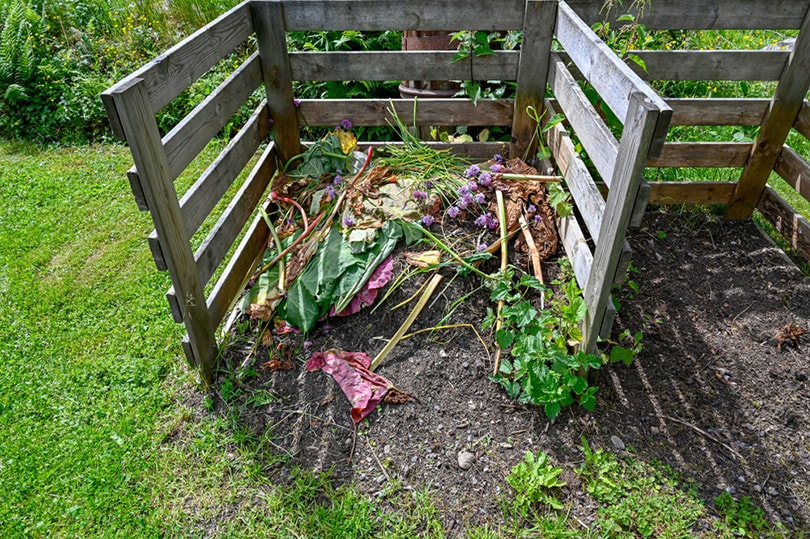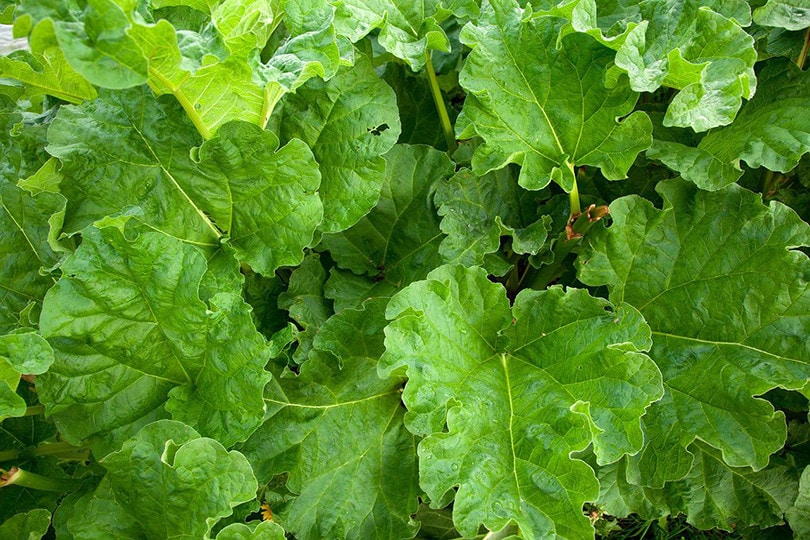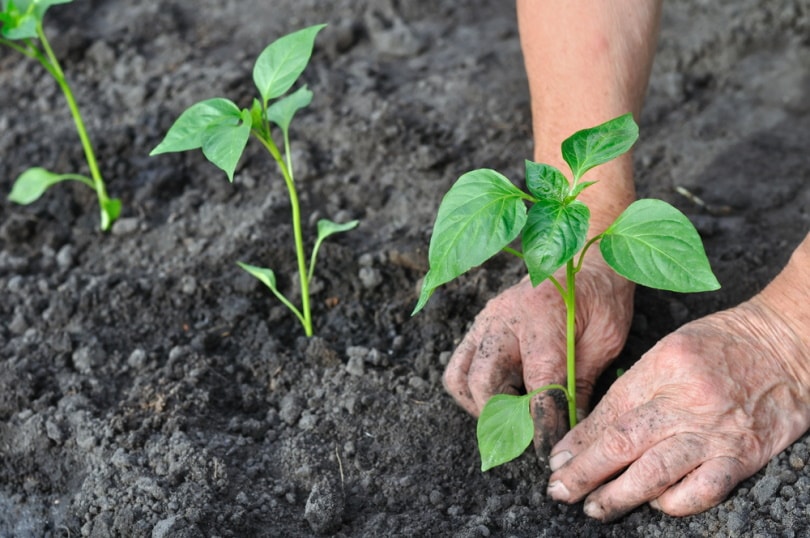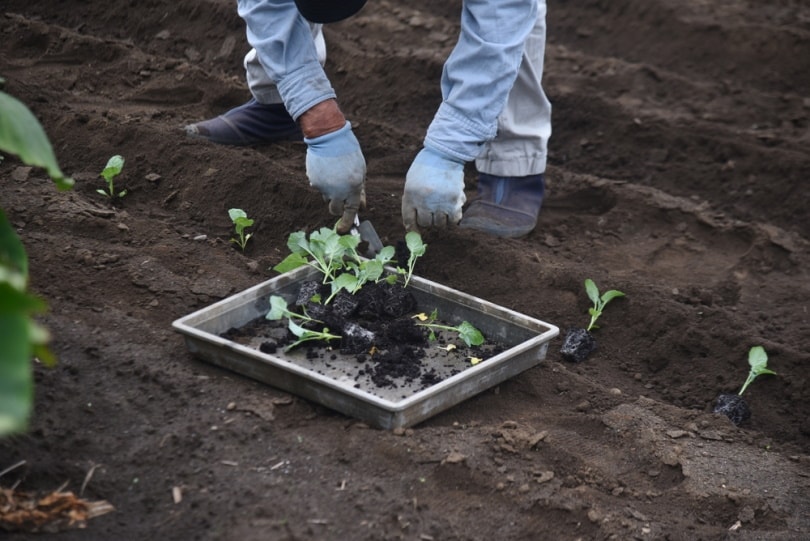How & When to Plant Rhubarb: Steps, Types, & Tips
-
Ed Malaker
- Last updated:

Rhubarb is a tasty plant that will enhance any garden. It grows easily almost anywhere in the northern United States, and it can produce a large harvest for many years. Keep reading as we provide you with a step-by-step guide to growing it successfully in your yard.
 Before You Begin
Before You Begin
Before you can plant any rhubarb, you will need to select one of the several varieties available.

Champagne
Champagne rhubarb is popular because it’s reliable and easy to grow. It produces long deep-red stems without much maintenance, and it’s quite tasty. It’s also one of the most common varieties that you will find.
Victoria
Victoria rhubarb produces a large crop each year and grows greenish-pink stems. People describe the flavor as a balance between sweet and bitter, so it’s perfect for pies and other hot desserts.
Raspberry Red
Raspberry red rhubarb gets its name from its thick deep-red stocks. It has a sweet flavor perfect for jelly, and you can begin harvesting it early in the season.
Thompson’s Terrifically Tasty
Thompson’s Terrifically Tasty rhubarb produces thick, pink, flavorsome stalks throughout early summer. It’s a fast grower, and the stems are often ready for harvest a full month before other varieties.
Fulton Strawberry Surprise
Fulton’s Strawberry Surprise is an eye-catching variety of rhubarb that has vivid red stems that you can see from a distance, so it will help improve the landscape. However, many people choose it because of its great flavor and large harvest.
Glaskin’s Perpetual
Glaskin’s Perpetual rhubarb is easy to grow and produces a small harvest in a single year in many cases.
The 8 Steps To Growing Rhubarb
1. Crown, Budded Piece, or Seed
Starting your rhubarb from seed is possible but difficult, and it could take a long time to produce its first harvest. Purchase a crown from your local garden center for the best results. A crown is last year’s crop that can grow to harvest the first year. A budded piece is a small section of the crown that will also work well but will usually take 2 years to produce a harvest.
2. When to Plant

Plant your rhubarb crown in the fall or early spring once the ground warms up. The soil should be damp but not soggy.
3. Choose a Good Spot
Although rhubarb will tolerate shade, you should choose a position that will help it get plenty of sunlight. It’s also important to remember that rhubarb could get quite large, and it also has long roots, so you’ll need to place it at least 30 inches from other plants.
4. Prepare the Soil

Once you have a good spot, you’ll need to prepare the soil. Go over the area carefully, removing any weeds. Then, use a pitchfork or shovel to break up the dirt to a depth of 6–12 inches. Adding in manure can help provide the nutrients that the rhubarb needs to grow quickly.
5. Plant
If planting the crown, spread out the roots, and place it so the tip of the crown is just above the soil. The rest of the crown and any budded pieces should be about 1 inch below the soil level. However, if the ground is hard or wet, you can place them closer to the surface. Put seeds about 1 inch below the surface, and water them frequently until they sprout.
6. Maintain

Remove any flowers that the rhubarb produces in spring to encourage faster, longer stem growth, which will result in a faster harvest.
Don’t let the rhubarb roots get too dry during the summer. Instead, water your plants more frequently as the temperature rises. It’s even more important to water if there isn’t much rain.
The leaves will start to die back in the fall, and you can cut back the old rhubarb stocks to leave the butt exposed. Placing manure around the crown will help it preserve moisture, reduce weeds, and provide nutrients throughout the winter.
Every 3 or 4 years, you’ll need to use a spade to lift the crown out of the ground and split it into three or four pieces. Doing so will help spread the plants and keep them productive.
7. Harvest
You shouldn’t harvest your rhubarb plant the first year, to help it get a stronger footing. However, from the 2nd year on, once the leaves unfurl and the stems are at least 12 inches long, you can harvest the stems from April through June. Remove the leaves and the entire stem is edible.
- Soil that has too much water or contains mold or fungus can cause the rhubarb to rot. If you notice rotting on the crown, you’ll need to cut away any affected areas.
- Snails and slugs are big problems for gardeners growing rhubarb because the large leaves can attract many each day. If you notice these critters, you’ll need to purchase a slug deterrent or try a DIY method like ground-up eggshells. However, avoid laying down too much salt, as it can change the pH of the soil.
 Summary
Summary
Growing rhubarb is not difficult, and it will likely come back year after year with almost no effort on your part. Watering it when it gets dry or providing fertilizer will help it grow faster and stronger. Splitting it every few years will help you get a larger harvest and keep the plants healthy. Many people report receiving 10 harvests or more from a single plant, so it’s more than worth the effort to grow.
Featured Image Credit By: bluejava1, Shutterstock
Contents
 Before You Begin
Before You Begin